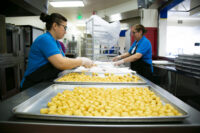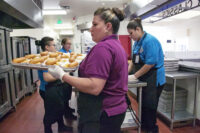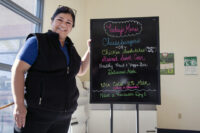Vicky Blankenship used to come home from work with her hands stained orange.
Blankenship started as a substitute lunch lady at Caldwell High School in 1986. Some days that meant peeling 25 pounds of carrots for dishes made from scratch.
“My hands would be orange for a week,” she remembers.
Now, much of the food prepared in the Caldwell High cafeteria comes pre-made. Children no longer have to pay for it. Kitchen staff are limited on how much salt they can add to foods. And every student is required to take fruit with their plate of free lunch.
In her 33 years with the Caldwell School District, Blankenship has worked every job in the child nutrition department, navigating shifting federal food standards along the way. She plans to retire in June, after five years as Caldwell’s child nutrition director.
“I never knew I was going to be a lunch lady my whole life,” Blankenship said.
Blankenship graduated from Caldwell High in 1973, in the era where school lunch cost around 50 cents and one of the most popular options was a peanut butter and honey sandwich on homemade bread.
Fast forward a decade or so, and Blankenship was back at Caldwell High, looking for a job that would match the hours her four kids were in school. Meal prep back then still meant pulling feathers out of poultry, she said. One of the students’ favorite dishes were “Cheese Yum-Yum’s” – basically baked cheese sandwiches.
“We made everything from scratch,” Blankenship said, “That was probably what I loved the most, we were able to make our food taste wonderful.”
Over the years, Blankenship worked in Caldwell elementary schools and became the kitchen manager at the high school. She took a job at the district office in 1997, and was promoted to director of the district’s child nutrition programs in 2014.
Healthy and Hunger Free Kids Act
The most significant change to child nutrition during Blankenship’s career was the Healthy and Hunger Free Kids Act signed by Congress in 2010.

The act created strict calorie counts for school meals, restricted sodium and required schools serve more produce and whole grains. The goal was to combat childhood obesity and encourage healthy eating.
The practical result, Blankenship said, is many kids stopped eating school lunch they didn’t like.
“We’ve been down the whole-wheat trail and it was a bust, really,” Blankenship said. “That’s when we started seeing how much food was going in the garbage.”
In the years since, Blankenship says, lunch ladies have won many of those children back.
Food providers and cafeteria chefs have learned how to make healthy food more appealing to the kids. Students are getting used to whole-wheat spaghetti. Changes to nutrition standards loosened whole-wheat requirements. And, the salad bars are a big hit with kids of every grade level, Blankenship said.
And maybe the biggest draw: All students in the Caldwell School District can now eat for free.

The Healthy and Hunger Free Kids Act created a community eligibility provision for schools that serve a high percentage of low-income students, allowing them to feed every student breakfast and lunch for free.
This is the fifth year the Caldwell district has been accepted to that CEP program, Blankenship said. Kids are eating again, because they’re willing to try the healthy food if it’s free.
“I think it’s wonderful to take the stigma away from the children who wouldn’t eat, because they didn’t have any money,” Blankenship said. “Or just the fact that there’s food available for them to take.”
This year, 1,100 of Caldwell High School’s 1,400 students take free meals.
“They come in a mad rush,” the school’s kitchen manager Patty Martin said last week, as her staff prepared to serve lunch.

The school’s kitchen smelled of baking bread. Cook Mary Muller stirred gravy for the day’s main meal: chicken fried steak, mashed potatoes and green beans. Meanwhile, 83-year-old Carmen Rivera sliced veggies for the cafeteria’s multiple salad bars as other women scooped tater tots and corn dogs into paper baskets.
Under the federal guidelines, all of the school’s lunch options have to fall within 750 and 850 calories for high school students.
The guidelines also mean Muller can’t season the food like she would when she owned her own restaurant in South Carolina, or when she first started with the district 15 years ago.
“It’s better for the kids,” she said of the food she serves today.
As Blankenship walked through the cafeteria at her former school, she was greeted with hugs from staff.
The cafeteria is a close-knit environment, Martin said. Muller picks Rivera up on her way to work in the mornings. The kitchen staff eats lunch together, and will make Martin join in if she’s busy.
And kids come by throughout the day, looking for their kitchen confidantes. Not only do the kitchen employees give students the nutrition they need to learn, Martin said, they’re also a friendly face, and a kind audience when the students need someone to talk to.
“I have some kids who call me Aunt Patty,” she said. OK, she jokes with them, “But you start calling me Grandma and we’re going to have some issues.”
On Friday, the district thanked these women for their commitment to the schools on School Lunch Hero Day.
Blankenship bought movie tickets for the ladies. The district caterer made them cupcakes. Children from elementary to high schools made signs to hang in the cafeterias, thanking their lunch ladies.
It was a bittersweet day for Blankenship, who will leave the district in June to spend time with her husband and help with three new grandchildren on the way.
“I really am proud of being a lunch lady,” she said. “What we do on a day-to-day basis is really important: to help children be successful.”
